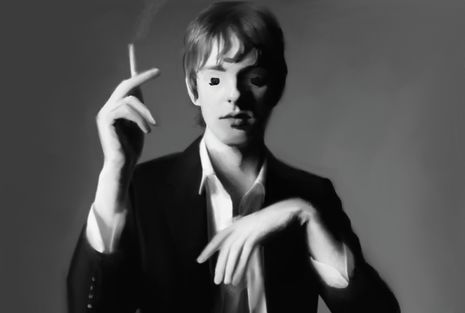I think he’s with it: The Dare debuts with What’s Wrong With New York
After his breakout feature on Charli XCX’s Guess, The Dare’s debut lands with chaotic energy and sharp critique. What’s Wrong With New York dissects modern nightlife — but is there more lurking beneath the noise?

On What’s Wrong With New York, Harrison Patrick Smith, known as The Dare, does more than revisit the sweaty electroclash and indie sleaze sounds of early-2000s New York. While comparisons to LCD Soundsystem are inevitable, Smith twists those familiar beats into something fresh, capturing the turbulence and disconnection that define today’s youth. At just over 27 minutes, the album rushes through jagged soundscapes, with tracks bleeding together in an unsettling blend of energy and ambivalence — reflecting the fractured nature of urban existence.
“What elevates this album beyond a mere sonic homage is its sharp undercurrent of cynical self-awareness”
What elevates this album beyond a mere sonic homage is its sharp undercurrent of cynical self-awareness. Beneath the throbbing beats and propulsive synths lies a deeper exploration of the tension between fleeting pleasures and the inevitable crash that follows. It’s not just an attempt to recycle sounds of the past; it reflects on chaos, serving as a distraction from something darker. While the album is rooted in New York’s underground scene, its themes resonate far beyond, extending to the cobbled streets of Cambridge.
The first thing that grabs you is its aggressively disorienting feel. From the opening track, ‘Open Up’, Smith throws listeners into a world of stuttering synths and driving beats. It’s music that demands attention, refusing to sit comfortably in the background. This sensation is familiar to anyone who’s experienced the disarming rush of nightlife, where temporary euphoria collides with the inevitability of a crash.
Tracks like ‘Good Time’ and ‘Perfume’ build on this, offering distorted takes on electroclash that channel the DIY spirit of the genre’s early days. Yet, rather than embracing the sleek, polished production often favoured in electronic music, Smith keeps things rough-edged. His vocals frequently feel submerged beneath layers of instrumentation, as if fighting to be heard. This push-pull between clarity and distortion generates a dynamic atmosphere that drives the album forward.
For listeners accustomed to the smooth exterior of mainstream pop, this rawness can feel confrontational, demanding engagement. Even tracks like ‘Girls’, which might initially seem like slutty party anthems, reveal a sharper critique beneath the surface. With repetitive hooks and chant-like vocals, the viral hit exposes the hollowness behind the pursuit of superficial pleasures.

‘Girls’ doesn’t just stand out sonically; it defines the thematic core of the album. Smith captures the existential side of nightlife, where the pursuit of pleasure often leads to confusion and emptiness. This isn’t music that flatters or soothes; it mirrors the cycles of escapism, thrill, and comedown, familiar to anyone wandering home through Cambridge’s quiet streets after the night ends too soon.
Yet What’s Wrong With New York resists nostalgia, even as it draws from electroclash influences. There’s a modern impatience in Smith’s sound — a refusal to indulge in retro fantasies. Nowhere is this clearer than on ‘I Destroyed Disco’, a track that deconstructs its predecessors. Rather than celebrating the liberation and joy disco once symbolised, Smith breaks it down with catchy synths and abrasive basslines. It’s less about homage and more about reinvention, tearing apart the foundations of the music that inspired him. The track speaks to a broader cultural moment, where the past is constantly revisited but rarely left unchallenged.
“Instead of glorifying escape, the album asks listeners to question the motivations behind it”
For all its chaotic energy, the album also offers a commentary on the darker side of escapism. Tracks like ‘All Night’, ‘Elevation’, and ‘You Can Never Go Home’ reveal a deeper realisation — one that confronts the emotional void left behind after the thrill fades, whether in a New York basement or the top floor of somewhere more ‘Vodka Revolution’-ary. Smith doesn’t just explore party life; he dissects it, exposing the hollowness that lingers once the crowds disperse. This tension between euphoria and emptiness gives the album its teeth, pushing beyond surface-level hedonism into more introspective territory.
Here, the album finds relevance beyond its immediate context. The Dare’s music resonates not because it offers escapism (“’cause there’s no escaping, no escaping”) but because it interrogates it, questioning so much more than the dance floor. At an academically rigorous institution like Cambridge, where the pressure to succeed — to “break records, glasses, faces” — often dovetails with a culture of reckless abandon, Smith’s critique feels pertinent. His portrayal of high-stakes lifestyles mirrors the pressure students feel, balancing academic demands with social expectations.
Instead of glorifying escape, the album asks listeners to question the motivations behind it — and, crucially, what’s left when the distraction fades. In this way, it isn’t just relevant to those entrenched in urban nightlife; it speaks to anyone caught in the cycle of seeking meaning through fleeting highs. Smith invites us to reconsider the value of those moments and challenges us to sit with the silence that follows.
In short, What’s Wrong With New York resists passive listening. Smith’s debut is deeply aware of its influences, but unafraid to tear them apart in creating something new. For Cambridge students, this record is more than just an electroclash revival: it’s a stark reminder that the pursuit of fleeting highs often comes with a cost.
The Dare’s debut asks listeners to sit with discomfort. It’s not an album that indulges nostalgia, but one that challenges us to reckon with the emptiness that comes after the thrill fades. In that sense, it’s an album for right now — a reflection of a culture desperate for meaning yet terrified to seek it. So, yeah, I think he might be with it.
 News / Clare Hall spent over £500k opposing busway 24 December 2025
News / Clare Hall spent over £500k opposing busway 24 December 2025 Comment / The ‘class’ of Cambridge24 December 2025
Comment / The ‘class’ of Cambridge24 December 2025 News / Eight Cambridge researchers awarded €17m in ERC research grants27 December 2025
News / Eight Cambridge researchers awarded €17m in ERC research grants27 December 2025 News / Caius mourns its tree-mendous loss23 December 2025
News / Caius mourns its tree-mendous loss23 December 2025 Comment / League tables do more harm than good26 December 2025
Comment / League tables do more harm than good26 December 2025









